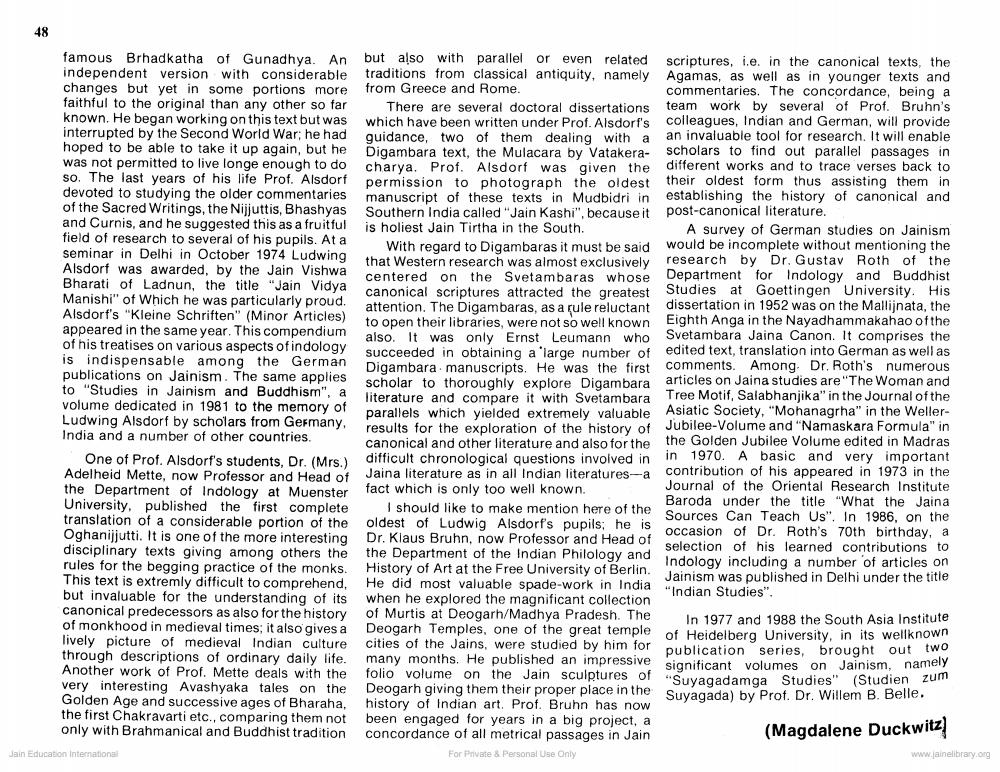________________
48
famous Brhadkatha of Gunadhya. An independent version with considerable changes but yet in some portions more faithful to the original than any other so far known. He began working on this text but was interrupted by the Second World War; he had hoped to be able to take it up again, but he was not permitted to live longe enough to do so. The last years of his life Prof. Alsdorf devoted to studying the older commentaries of the Sacred Writings, the Nijjuttis, Bhashyas and Curnis, and he suggested this as a fruitful field of research to several of his pupils. At a seminar in Delhi in October 1974 Ludwing Alsdorf was awarded, by the Jain Vishwa Bharati of Ladnun, the title "Jain Vidya Manishi" of Which he was particularly proud. Alsdorf's "Kleine Schriften" (Minor Articles) appeared in the same year. This compendium of his treatises on various aspects of indology is indispensable among the German publications on Jainism. The same applies to "Studies in Jainism and Buddhism", a volume dedicated in 1981 to the memory of Ludwing Alsdorf by scholars from Germany. India and a number of other countries.
One of Prof. Alsdorf's students, Dr. (Mrs.) Adelheid Mette, now Professor and Head of the Department of Indology at Muenster University, published the first complete translation of a considerable portion of the Oghanijjutti. It is one of the more interesting disciplinary texts giving among others the rules for the begging practice of the monks. This text is extremly difficult to comprehend. but invaluable for the understanding of its canonical predecessors as also for the history of monkhood in medieval times; it also gives a lively picture of medieval Indian culture through descriptions of ordinary daily life. Another work of Prof. Mette deals with the very interesting Avashyaka tales on the Golden Age and successive ages of Bharaha, the first Chakravarti etc., comparing them not only with Brahmanical and Buddhist tradition
Jain Education International
but also with parallel or even related traditions from classical antiquity, namely from Greece and Rome.
There are several doctoral dissertations which have been written under Prof. Alsdorf's guidance, two of them dealing with a Digambara text, the Mulacara by Vatakeracharya. Prof. Alsdorf was given the permission to photograph the oldest manuscript of these texts in Mudbidri in Southern India called "Jain Kashi", because it is holiest Jain Tirtha in the South.
With regard to Digambaras it must be said that Western research was almost exclusively centered on the Svetambaras whose canonical scriptures attracted the greatest attention. The Digambaras, as a rule reluctant to open their libraries, were not so well known also. It was only Ernst Leumann who succeeded in obtaining a 'large number of Digambara manuscripts. He was the first scholar to thoroughly explore Digambara literature and compare it with Svetambara parallels which yielded extremely valuable results for the exploration of the history of canonical and other literature and also for the difficult chronological questions involved in Jaina literature as in all Indian literatures-a fact which is only too well known.
I should like to make mention here of the oldest of Ludwig Alsdorf's pupils; he is Dr. Klaus Bruhn, now Professor and Head of the Department of the Indian Philology and History of Art at the Free University of Berlin. He did most valuable spade-work in India when he explored the magnificant collection of Murtis at Deogarh/Madhya Pradesh. The Deogarh Temples, one of the great temple cities of the Jains, were studied by him for many months. He published an impressive folio volume on the Jain sculptures of Deogarh giving them their proper place in the
history of Indian art. Prof. Bruhn has now been engaged for years in a big project, a concordance of all metrical passages in Jain
For Private & Personal Use Only
scriptures, i.e. in the canonical texts, the Agamas, as well as in younger texts and commentaries. The concordance, being a team work by several of Prof. Bruhn's colleagues, Indian and German, will provide an invaluable tool for research. It will enable scholars to find out parallel passages in different works and to trace verses back to their oldest form thus assisting them in establishing the history of canonical and post-canonical literature.
A survey of German studies on Jainism would be incomplete without mentioning the research by Dr. Gustav Roth of the Department for Indology and Buddhist Studies at Goettingen University. His dissertation in 1952 was on the Mallijnata, the Eighth Anga in the Nayadhammakahao of the Svetambara Jaina Canon. It comprises the edited text, translation into German as well as comments. Among. Dr. Roth's numerous articles on Jaina studies are "The Woman and Tree Motif, Salabhanjika" in the Journal of the Asiatic Society, "Mohanagrha" in the WellerJubilee-Volume and "Namaskara Formula" in the Golden Jubilee Volume edited in Madras in 1970. A basic and very important contribution of his appeared in 1973 in the Journal of the Oriental Research Institute Sources Can Teach Us". In 1986, on the Baroda under the title "What the Jaina occasion of Dr. Roth's 70th birthday, a selection of his learned contributions to Indology including a number of articles on Jainism was published in Delhi under the title "Indian Studies".
of Heidelberg University, in its wellknown In 1977 and 1988 the South Asia Institute publication series, brought out two significant volumes on Jainism, namely Suyagadamga Studies" (Studien zum Suyagada) by Prof. Dr. Willem B. Belle.
(Magdalene Duckwitz]
www.jainelibrary.org




